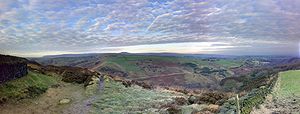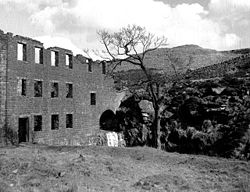
Cheesden Valley
Encyclopedia

Heywood, Greater Manchester
Heywood is a town within the Metropolitan Borough of Rochdale, in Greater Manchester, England. It lies on the south bank of the River Roch and is east of Bury, west-southwest of Rochdale, and north of the city of Manchester. The town of Middleton lies to the south, whilst to the north is the...
area of Greater Manchester
Greater Manchester
Greater Manchester is a metropolitan county in North West England, with a population of 2.6 million. It encompasses one of the largest metropolitan areas in the United Kingdom and comprises ten metropolitan boroughs: Bolton, Bury, Oldham, Rochdale, Stockport, Tameside, Trafford, Wigan, and the...
, England. It runs on a north-south alignment between Bury
Bury
Bury is a town in Greater Manchester, England. It lies on the River Irwell, east of Bolton, west-southwest of Rochdale, and north-northwest of the city of Manchester...
and Rochdale
Rochdale
Rochdale is a large market town in Greater Manchester, England. It lies amongst the foothills of the Pennines on the River Roch, north-northwest of Oldham, and north-northeast of the city of Manchester. Rochdale is surrounded by several smaller settlements which together form the Metropolitan...
in the Metropolitan Borough of Rochdale
Metropolitan Borough of Rochdale
The Metropolitan Borough of Rochdale is a metropolitan borough of Greater Manchester in North West England. It is named after its largest town, Rochdale, but spans a far larger area which includes the towns of Middleton, Heywood, Littleborough and Milnrow, and the village of Wardle.The borough was...
. Cheesden Brook runs through the valley, joining with Naden Brook
Naden Brook
Naden Brook is a watercourse in north west England. It rises in the hills above Norden, near the boundary of Lancashire and Greater Manchester...
to eventually run into the River Roch
River Roch
The River Roch is a river in Greater Manchester in North West England, a tributary of the River Irwell that gives Rochdale its name.-Course:...
near Heywood. During the industrial age
Industrialisation
Industrialization is the process of social and economic change that transforms a human group from an agrarian society into an industrial one...
the valley became a centre of cotton production dependent on running water. The valley is now a conservation area.
Pre-Industrial History
There are signs of human activity in Heywood dating from about 8000 BC. Flints from the MesolithicMesolithic
The Mesolithic is an archaeological concept used to refer to certain groups of archaeological cultures defined as falling between the Paleolithic and the Neolithic....
period have been found in Heywood, in the Cheesden Valley and Knowl Moor areas. All were discovered on high ground close to a water source, and all are quite small and suitable for use as arrowheads and similar objects.
According to a report on an archaeological survey of the Metropolitan Borough of Rochdale
Metropolitan Borough of Rochdale
The Metropolitan Borough of Rochdale is a metropolitan borough of Greater Manchester in North West England. It is named after its largest town, Rochdale, but spans a far larger area which includes the towns of Middleton, Heywood, Littleborough and Milnrow, and the village of Wardle.The borough was...
(which appeared in the Greater Manchester Archaeological Journal in 1985) it is likely that the flints were not left by early residents of Heywood, but rather by bands of hunters.
In later times, the people who farmed the inhospitable countryside made a living by weaving - mostly wool from their own sheep - using a handloom, and the early mills were designed to help them with the supply of yarn and the provision of ancillary services.
Mining
As early as 1580, Queen Elizabeth I granted one John Blackwall the right to mine coal in the Cheesden Valley. In addition, it is believed that during the 17th century small communities – ‘Folds’ – could have had their own mines.Mills
The first mill in the valley was probably erected at Kershaw Bridge in 1780 by Thomas Allanson. It was a fustianFustian
Fustian is a term for a variety of heavy woven, mostly cotton fabrics, chiefly prepared for menswear. It is also used to refer to pompous, inflated or pretentious writing or speech, from at least the time of Shakespeare...
mill and may have used Arkwright
Richard Arkwright
Sir Richard Arkwright , was an Englishman who, although the patents were eventually overturned, is often credited for inventing the spinning frame — later renamed the water frame following the transition to water power. He also patented a carding engine that could convert raw cotton into yarn...
water frames.
John Haworth's Four-Acre Mill was high on the moors above Cheesden and was powered by a 36 feet (11 m) waterwheel. Haworth, who diverted the waters of a tributary stream to turn his wheel, later built a huge lodge to provide a consistent head of water for himself and other millowners - until then, they had been at the whim of the weather, laying off workers during dry spells and calling them in at all hours when the valley flooded.
A John Kay (not to be confused with the John Kay
John Kay (flying shuttle)
John Kay was the inventor of the flying shuttle, which was a key contribution to the Industrial Revolution. He is often confused with his namesake: fellow Lancastrian textile machinery inventor, the unrelated John Kay who built the first "spinning frame".-Life in England:John Kay was born...
who invented the flying shuttle
Flying shuttle
The flying shuttle was one of the key developments in weaving that helped fuel the Industrial Revolution. It was patented by John Kay in 1733. Only one weaver was needed to control its lever-driven motion. Before the shuttle, a single weaver could not weave a fabric wider than arms length. Beyond...
) built Cheesden Valley's Lumb Mill in 1786, as a fulling mill, turning woollens into felted materials.
Cheesden Brook provided power for at least 15 mills and employment for 2,000 people. Communities grew up in what had once been a desolate region.
These moorland mills held their own for more than half a century against their big-town rivals, many finding a niche for themselves, as mainline competition increased, by developing as cotton-waste spinners. This involved recycling the inner core of yarn cops, which had been stiffened in manufacture by the application of starch paste to avoid the need for separate wooden bobbin
Bobbin
A bobbin is a spindle or cylinder, with or without flanges, on which wire, yarn, thread or film is wound. Bobbins are typically found in sewing machines, cameras, and within electronic equipment....
s. During the cotton famine caused by the American Civil War
American Civil War
The American Civil War was a civil war fought in the United States of America. In response to the election of Abraham Lincoln as President of the United States, 11 southern slave states declared their secession from the United States and formed the Confederate States of America ; the other 25...
these waste mills actually experienced a boom.
By the 1870s the mills were struggling to compete against the steam-powered economics of their massive rivals in the nearby towns and, before the turn of the century, they had all but vanished. Many of the former mills, lodges and a solitary chimney, along with other industrial workings such as Weirs and Dykes, are still evident today.

List of Mills
- Four Acre
- Cheesden Pasture (app. b. 1810)
- Lower Pasture
- Cheesden Bar
- Cheesden Lumb Upper
- Cheesden Lumb Lower
- Longlands
- Croston Close Upper
- Croston Close Lower
- Deeply Hill
- Deeply Vale
- Washwheel
- Birtle Dene
- Kershaw Bridge

